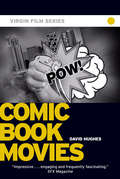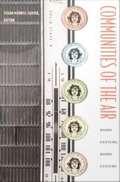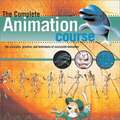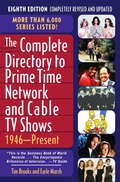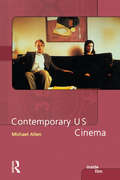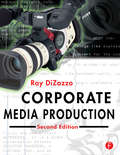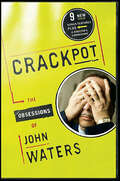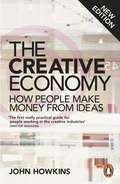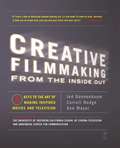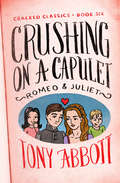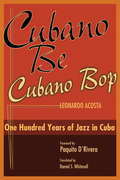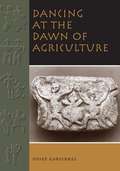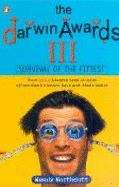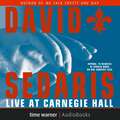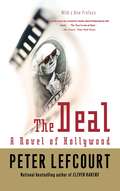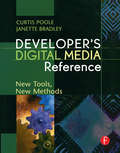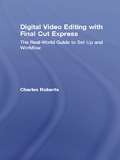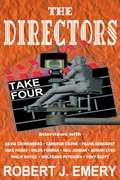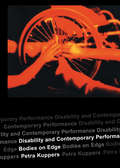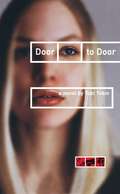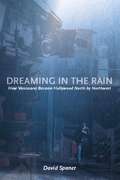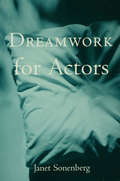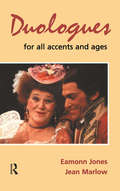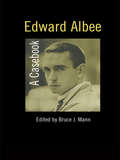- Table View
- List View
Comic Book Movies - Virgin Film
by David HughesThe superheroes are back! Since the 1970s, the film world has found inspiration in comic books and graphic novels. These days no summer is complete without a major blockbuster movie based on a comic: Superman, Batman, Spider-Man, X-Men, Men in Black, Daredevil, and The Hulk. Modern special effects have made large-scale superhero epics possible, but the diversity of the comics being published has made for a wide variety of subjects, as evidenced by Ghost World, From Hell, Akira and Road to Perdition. This book looks in detail at twenty key titles, covering every step of the development from comic book panel to feature film frame. Includes interviews with key creative artists about the evolution of the films from the original comics, and speculates about future films.
Communities of the Air: Radio Century, Radio Culture
by Susan Merrill SquierA pioneering analysis of radio as both a cultural and material production, Communities of the Air explores radio's powerful role in shaping Anglo-American culture and society since the early twentieth century. Scholars and radio writers, producers, and critics look at the many ways radio generates multiple communities over the air--from elite to popular, dominant to resistant, canonical to transgressive. The contributors approach radio not only in its own right, but also as a set of practices--both technological and social--illuminating broader issues such as race relations, gender politics, and the construction of regional and national identities. Drawing on the perspectives of literary and cultural studies, science studies and feminist theory, radio history, and the new field of radio studies, these essays consider the development of radio as technology: how it was modeled on the telephone, early conflicts between for-profit and public uses of radio, and amateur radio (HAMS), local programming, and low-power radio. Some pieces discuss how radio gives voice to different cultural groups, focusing on the BBC and poetry programming in the West Indies, black radio, the history of alternative radio since the 1970s, and science and contemporary arts programming. Others look at radio's influence on gender (and gender's influence on radio) through examinations of Queen Elizabeth's broadcasts, Gracie Allen's comedy, and programming geared toward women. Together the contributors demonstrate how attention to the variety of ways radio is used and understood reveals the dynamic emergence and transformation of communities within the larger society. Contributors. Laurence A. Breiner, Bruce B. Campbell, Mary Desjardins, Lauren M. E. Goodlad, Nina Hunteman, Leah Lowe, Adrienne Munich, Kathleen Newman, Martin Spinelli, Susan Merrill Squier, Donald Ulin, Mark Williams, Steve Wurzler
The Complete Animation Course: The Principles, Practice and Techniques of Successful Animation
by Chris PatmoreDesktop computer artists will find a wealth of information in this heavily illustrated book. It instructs in the principles, practice, and techniques of successful animation. The author covers all forms of animation, starting with the basics of making sketches in flip books, and concluding with the latest developments in computer-generated imagery. He demonstrates with practical examples that utilize key areas of modern animation cell art, stop-action with clay or plastic models, and 3D computer-generated and web-based animations. This volume's six chapters cover the following topics: The art of storytelling and storyboarding . . . How to create stop-action animation . . . Simple cell animation, the technique for simple movie cartoon sequences . . . Full cell animation, as used by Disney, Warner Brothers, and similar studios . . . Web animation for showcasing your skill over the Internet . . . and Computer modeling and animation, including 3D modeling. The book's concluding sections discuss modern hardware and software, with emphasis on affordable beginners' equipment. Also provided is an overview of the animation industry and its applications to movies, TV, and computer games. More than 250 instructive illustrations enhance this fascinating how-to volume.
The Complete Directory to Prime Time Network and Cable TV Shows 1946—Present (Eighth Edition)
by Tim Brooks Earle MarshAMERICA'S #1 BESTSELLING TELEVISION BOOK WITH MORE THAN HALF A MILLION COPIES IN PRINT-NOW REVISED AND UPDATED!PROGRAMS FROM ALL SEVEN COMMERCIAL BROADCAST NETWORKS, MORE THAN SIXTY CABLE NETWORKS,PLUS ALL MAJOR SYNDICATED SHOWS!This is the must-have book for TV viewers in the new millennium-the entire history of prime-time programs in one convenient volume. It's a guide you'll turn to again and again for information on every series ever telecast. There are entries for all the great shows, from evergreens like I Love Lucy, The Honeymooners, and Happy Days, to modern classics like Will & Grace, Buffy the Vampire Slayer, and Friends; all the gripping sci-fi series, from Captain Video and The X-Files to all versions of Star Trek; the popular serials, from Peyton Place to Dallas to Dawson's Creek; and the runaway hits on cable, including CNN, The Real World, The Osbournes, and Sponge Bob Square Pants. This comprehensive guide lists every program alphabetically and includes a complete broadcast history, cast, and engaging plot summary- along with exciting behind-the-scenes stories about the shows and the stars.MORE THAN 500 ALL-NEW LISTINGS, from Survivor and The Bachelor to C.S.I. and The West Wing. UPDATES ON CONTINUING SHOWS, such as ER, Frasier, 7th Heaven, and The Simpsons.EXTENSIVE CABLE COVERAGE of more than 800 entries, including a description of the programming on each major cable network.BRAND-NEW IN THIS EDITION-an exclusive "Ph.D. Trivia Quiz" of two hundred questions to challenge even the most ardent TV fan; plus a streamlined guide to TV-related Web sites for all those who want to be constantly up-to-date.SPECIAL FEATURES!* Annual program schedules at a glance for the past fifty-seven years * Top-rated shows of each season * Emmy Award winners * Longest running series * Spin-off series * Theme songs * A fascinating history of TVFrom the Trade Paperback edition.
Contemporary US Cinema (Inside Film)
by Michael AllenContemporary U.S. Cinema is a forceful exploration of the tumultuous changes that have dominated the shifting landscape of American film-making over the past three decades. From the explosive release of Easy Rider to the excesses of Heaven's Gate and the comic book figures of Spider-Man, its aim is to examine the economic, social and cultural contexts of mainstream and independent American films. The book divides into nine provocative chapters with material on: the most significant individual film-makers, such as Scorsese, Coppola and Lucas, as well as independent film-makers like Jarmusch and Anders the careers of leading actors of the last thirty years, such as Jack Nicholson, Robert Redford and Julia Roberts, whilst exploring the powerful position of the film star in the modern American film-making process the economics of Contemporary U.S. Cinema with particular reference to the tortuous journey from production, distribution and exhibition of Waterworld and Titanic the artistic influence of foreign film-makers, such as François Truffaut and Jean-Luc Godard, and explores Hollywood's increasing dominance and reliance on the global market genres, sequels and the recent developments in computer-based technologies, using examples from The Godfather I - III, The Matrix, the Star Wars saga and remakes from Shaft to Ocean's Eleven The book is illustrated with stills throughout and includes a bibliography and annotated further reading list.
Corporate Media Production
by Ray DiZazzoWith the advent of affordable equipment, there are more opportunities than ever in the field of corporate media production. This book examines all aspects of this creative field, from concept development to the final stages of postproduction. The book also clarifies the roles of the writer, producer, director and client while focusing on the dynamics among these key players. This in-depth book captures all the technical and creative elements used in the creation of media in the corporate world. The new edition has been updated to reflect the most current media production, editing, delivery formats and processes, with an emphasis on DV. There is material on the new digital video cameras and non-linear editing systems, as well as an expanded discussion of audio sweetening. A new chapter on evaluation demystifies this critical process, and there is a new discussion of multimedia.
Crackpot: The Obsessions of John Waters
by John WatersAn outrageous collection from the uniquely legendary John Waters, updated with new material—including Waters&’s 2002 New York Times article, &“Finally, Footlights on the Fat Girls.&”Crackpot, originally released in 1986, is John Waters&’s brilliantly entertaining litany of odd and fascinating people, places, and things. From Baltimore to Los Angeles, from William Castle to Pia Zadora, from the National Enquirer to Ronald Reagan&’s colon, Waters explores the depths of our culture. And he dispenses useful advice along the way: how not to make a movie, how to become famous (read: infamous), and of course, how to most effectively shock and make our nation&’s public laugh at the same time. Loaded with bonus features, this special edition is guaranteed to leave you totally mental.
The Creative Economy: How People Make Money from Ideas
by John HowkinsCreativity is the fastest growing business in the world.Companies are hungry for people with ideas - and more and more of us want to make, buy, sell and share creative products. But how do you turn creativity into money? In this newly rewritten edition of his acclaimed book, leading creative expert John Howkins shows what creativity is, how it thrives and how it is changing in the digital age. His key rules for success include:Invent yourself. Be unique.Own your ideas. Understand copyright, patents and IP laws. Treat the virtual as real, and vice versa.Learn endlessly: borrow, reinvent and recycle.Know when to break the rules.Whether in film or fashion, software or stories, by turning ideas into assets anyone can make creativity pay.
Creative Filmmaking from the Inside Out
by Jed Dannenbaum Carroll Hodge Doe MayerFive keys to creating authentic, distinctive work, whether you are a student, professional or simply love making films on your own For Creative Filmmaking from the Inside Out, three professors at the renowned University of Southern California School of Cinema-Television interviewed fifteen outstanding filmmakers, then distilled their insights into the "Five I's" of creativity. Learn how to: Uncover your unique creative voice (Introspection) Work from real-life observations and experience (Inquiry) Draw on your nonconscious wells of creativity (Intuition) Strengthen your creative collaborations (Interaction) Communicate at the deepest level with your audience (Impact) This comprehensive approach provides practical exercises that will enrich and transform your work, whether you are looking for a story idea, lighting a set, editing a scene or selecting a music cue. The participating filmmakers, who have collectively won or been nominated for 39 Oscars and 27 Emmys, are: Anthony Minghella, writer-director (The English Patient); Kimberly Peirce, writer-director (Boys Don't Cry); John Lasseter, writer-director-producer (Toy Story); John Wells, writer-producer (ER); Hanif Kureishi, writer (My Beautiful Laundrette); Pamela Douglas, writer (Between Mother and Daughter); Renee Tajima-PeÑa, director-producer (My America...or, Honk If You Love Buddha); Ismail Merchant, producer (The Remains of the Day); Jeannine Oppewall, production designer (L.A. Confidential); Conrad L. Hall, cinematographer (American Beauty); Kathy Baker, actor (Picket Fences); Walter Murch, sound designer-editor (Apocalypse Now); Lisa Fruchtman, editor (The Right Stuff); Kate Amend, editor (Into the Arms of Strangers); and James Newton Howard, composer (The Sixth Sense).
Crushing on a Capulet: (Romeo & Juliet) (Cracked Classics #6)
by Tony AbbottSixth graders Devin and Frankie try to save star-crossed lovers Romeo and Juliet when they&’re magically transported into Shakespeare&’s classic play. When their teacher assigns Devin and Frankie—short for Francine—the lead roles in their class production of Romeo and Juliet, the two best friends aren&’t thrilled. How are they supposed to say their lines when they don&’t even sound like they were written in English? Luckily, the library&’s magic security gates come to their rescue again, and they leap into Shakespeare&’s famous tragedy. Unfortunately, they land right in the middle of a sword fight between two warring families, the Montagues and the Capulets. When they find out that Romeo Montague has fallen in love with Juliet Capulet, Devin and Frankie decide it&’s up to them to make sure this unlikely couple lives happily ever after. But can they change the book&’s tragic end and save the young lovers from their fate? &“The message that reading is important and can be fun comes through loud and clear,&” writes School Library Journal about the Cracked Classics series. &“The short chapters make this an ideal read-aloud and a treat for reluctant readers.&”
Cubano Be, Cubano Bop: One Hundred Years of Jazz in Cuba
by Leonardo Acosta Daniel Whitesell Paquito D'RiveraBased on unprecedented research in Cuba, the direct testimony of scores of Cuban musicians, and the author's unique experience as a prominent jazz musician, Cubano Be, Cubano Bop is destined to take its place among the classics of jazz history. The work pays tribute not only to a distinguished lineage of Cuban jazz musicians and composers, but also to the rich musical exchanges between Cuban and American jazz throughout the twentieth century.The work begins with the first encounters between Cuban music and jazz around the turn of the last century. Acosta writes about the presence of Cuban musicians in New Orleans and the "Spanish tinge" in early jazz from the city, the formation and spread of the first jazz ensembles in Cuba, the big bands of the thirties, and the inception of "Latin jazz." He explores the evolution of Bebop, Feeling, and Mambo in the forties, leading to the explosion of Cubop or Afro-Cuban jazz and the innovations of the legendary musicians and composers Machito, Mario Bauzá, Dizzy Gillespie, and Chano Pozo. The work concludes with a new generation of Cuban jazz artists, including the Grammy award-winning musicians and composers Chucho Valdés and Paquito D'Rivera.
Dancing at the Dawn of Agriculture
by Yosef GarfinkelAs the nomadic hunters and gatherers of the ancient Near East turned to agriculture for their livelihood and settled into villages, religious ceremonies involving dancing became their primary means for bonding individuals into communities and households into villages. So important was dance that scenes of dancing are among the oldest and most persistent themes in Near Eastern prehistoric art, and these depictions of dance accompanied the spread of agriculture into surrounding regions of Europe and Africa. In this pathfinding book, Yosef Garfinkel analyzes depictions of dancing found on archaeological objects from the Near East, southeastern Europe, and Egypt to offer the first comprehensive look at the role of dance in these Neolithic (7000-4000 BC) societies. In the first part of the book, Garfinkel examines the structure of dance, its functional roles in the community (with comparisons to dance in modern pre-state societies), and its cognitive, or symbolic, aspects. This analysis leads him to assert that scenes of dancing depict real community rituals linked to the agricultural cycle and that dance was essential for maintaining these calendrical rituals and passing them on to succeeding generations. In the concluding section of the book, Garfinkel presents and discusses the extensive archaeological data—some 400 depictions of dance—on which his study is based.
The Darwin Awards III
by Wendy NorthcuttThe humour evolution takes another giant step One of the human race's most popular humour series returns with a brand-new collection of hilariously macabre mishaps and misadventures, honouring those who improve our gene pool by inadvertently removing themselves from it. The Darwin Awards III: Survival of the Fittest shows once more how uncommon common sense still is. Celebrate Darwin Award winners who made the 'ultimate sacrifice'; wonder at the misguided pluck of Honorable Mentions who survived their own bad judgment, and look on in awestruck amusement at Personal Accounts shared by the perpetrators themselves. From the sheriff who inadvertently shot himself twice to the insurance defrauder who amputated his leg with a chainsaw, The Darwin Awards III proves again that when it comes to stupidity, we are the most advanced species on the planet.
David Sedaris Live at Carnegie Hall
by David SedarisNo one renders the pathos, chaos and impossible variety of daily encounters like David Sedaris. On every subject, he is bruisingly painful and tenderly affectionate. Recorded live on October 22, 2002, LIVE AT CARNEGIE HALL features excerpts from his forthcoming collection of essays, DRESS YOUR FAMILY IN CORDUROY AND DENIM.Includes:ThanksRepeat After MeWhy Them?Who's the Chef?Buddy Can You Spare a Tie?LessonThree: The Feminine MistakeLesson Four: With a Pal Like This, You Don't Need An EnemySix to Eight Black Men
The Deal
by Peter LefcourtWashed-up Hollywood producer Charlie Berns has mailed in his updated obit and is about to suck his Mercedes tailpipe and fade to black when a miracle materializes: his nephew, a wannabe screenwriter from New Jersey, has scripted the life story of Queen Victoria's prime minister Benjamin Disraeli, which Charlie manages to turn into a hot property that reinstates him as a player. But as the deal heats up, a few conceptual changes morph the project into Lev Disraeli: Freedom Fighter, an action thriller with a black Jewish superstar, a Yugoslavian location, a mad Polish director, and even a real-life kidnapping. Is Charlie Berns being eaten alive by the system? Or is he giving the Hollywood hotshots a run for their money? Peter Lefcourt's hilarious satire proves the old adage that in Hollywood you're never quite as dead as people give you credit for.
Developer's Digital Media Reference: New Tools, New Methods
by Curtis Poole Janette BradleyDesigned for media professionals working across a broad range of formats, Developer's Digital Media Reference is an excellent reference guide for those keeping pace with this dynamic industry. As "convergence" between the World Wide Web, multimedia, and television production communities continues, there is an increased demand for professionals to familiarize themselves with the many new delivery contexts, including hybrid DVD (where digital video content and computer data live on the same disc), interactive TV, and streaming media. Developer's Digital Media Reference covers essential technologies such as SVG (scalable vector graphics), SMIL (Synchronized Multimedia Integration Language, a markup language for creating animations on the web), MPEG-4 (compression standard for streaming audio/video), and Dynamic Web Applications. In addition to serving as a quick-look-up guide, this text is organized to explain today's major media: server-based architectures, disc-based architectures, distribution architectures, and merging/shared architectures. Each topic is discussed in terms of the technological background-evolution, current tools, and production tips and techniques.
Digital Video Editing with Final Cut Express: The Real-World Guide to Set Up and Workflow
by Charles RobertsSuitable for those new to nonlinear editing as well as experienced editors new to Final Cut Express, this book is an introduction to Apple's editing software package and the digital video format in general. You will come away with not only an in-depth knowledge of how to use Final Cut Express, but also a deeper understanding of the craft of editing and the underlying technical processes that will serve you well in future projects. Workflow, editing techniques, compositing, special effects, audio tools, and output are explained in clear, jargon-free terms. The book's emphasis is always on using Final Cut Express in the real world, and as such it is the only book to go beyond the interface to address crucial issues like proper setup, system configuration, hardware, the Mac operating system, what equipment to purchase, and troubleshooting common problems. Armed with this information, you will sidestep problems and complete projects of exceptional quality.
The Directors: Take Three (The\directors Ser.)
by Robert J. EmeryThe Directors, Take Three offers dozens of masterful insights on the craft of directing from such renowned filmmakers as Robert Altman, Wes Craven, Alan Parker, Tim Burton, Steven Spielberg, and Barry Levinson. Here are details of their experiences making a variety of classic films from Nashville to Nightmare on Elm Street, Rain Man to Raging Bull, and Pee Wee's Big Adventure to Schindler's List. You'll discover directors' earliest reactions to scripts for films that became classics; how legendary scenes were staged and shot; behind-the-scenes stories of the unknown actors who landed major roles and went on to become superstars; the underdog films that confounded expectations; directors' unique approaches to their art; and much, much more. This magnificent series also includes each director's filmography, complete listings of major awards, and cast credits for every film discussed. A fabulous source of insights, anecdotes, and industry secrets for film buffs everywhere!
Disability and Contemporary Performance: Bodies on the Edge
by Petra KuppersDisability and Contemporary Performance presents a remarkable challenge to existing assumptions about disability and artistic practice. In particular, it explores where cultural knowledge about disability leaves off, and the lived experience of difference begins. Petra Kuppers, herself an award-winning artist and theorist, investigates the ways in which disabled performers challenge, change and work with current stereotypes through their work. She explores freak show fantasies and 'medical theatre' as well as live art, webwork, theatre, dance, photography and installations, to cast an entirely new light on contemporary identity politics and aesthetics. This is an outstanding exploration of some of the most pressing issues in performance, cultural and disability studies today, written by a leading practitioner and critic.
The Dog Of My Nightmares
by David LieberStories and columns ranging from serious to hilarious written by a popular Texas columnist. Read about the woman of his dreams, the psycho dog of his nightmares, neighbors, thoughts of prejudice, and pride in the strength of our people.
Door to Door
by Tobi TobinIn this edgy, frenetic fictionalized memoir, a small-town girl turned linchpin of the Los Angeles club scene draws on her intoxicating but conflicted years working the door of Hollywood's hottest clubs to pen a striking story of ambition, loss, and love. After growing up in idyllic Bloomfield Hills, Michigan, seventeen-year-old Tobi leaves behind a childhood that was anything but idyllic and chases her dreams of modeling to New York. When the Big Apple turns out to be a bust, Tobi finds her way to L.A. and to the fringes of the film world elite. Hungry for an "in" she gets busy barhopping, party-going, and producer-hunting, eventually falling into a beautiful but complicated relationship with a famous actor. Though her own acting career never takes off, a chance encounter lands her a job working the door of an old friend's club. A whole new world opens up. Raw and revealing, Door to Door is both an unprecedented glimpse into the L.A. club scene and the riveting story of a girl who puts it all on the line for her chance to become somebody.
Dreaming in the Rain
by David SpanerVancouver is now North America's third largest center for film and television production, recently witnessing the filming of Halle Berry's Catwoman and Will Smith's I, Robot, among others. But Vancouver has been hosting filmmakers for years, coming into its own in the early 1970s when Robert Altman, Warren Beatty and Julie Christie made McCabe and Mrs. Miller and Mike Nichols, Jack Nicholson and Candice Bergen filmed Carnal Knowlege.Dreaming in the Rain tells the story of how Vancouver became North by Northwest, from its early days as a Hollywood studio backlot to its becoming home to a vibrant indigenous scene that is among the most acclaimed, provocative, independent filmmaking communities anywhere.But with Hollywood's growing concern over "runaway" productions, Vancouver's growing filmmaking scene is wrought with controversy. The city's American-based film industry is powerful enough to inspire loathing and threats from Hollywood.Along with tracing the art and commerce of Vancouver filmmaking, Vancouver Province movie critic David Spaner brings to life the flamboyant film personalities who left their marks. From visitors like Errol Flynn and Robert Altman, to local heroes such as The Matrix's Carrie Anne Moss, who grew up in Vancouver, and Kissed star Molly Parker and director Lynne Stopkewich, vital players in the groundbreaking Vancouver indie scene.Includes more than 40 black and white photographs.". . . [Spaner] has . . . scrupulous attention to detail and an obvious curiosity and passion for both Vancouver and its film industry."--Entertainment TodayDavid Spaner is a movie critic for the Vancouver Province.
Dreamwork for Actors
by Janet SonenbergDrawing upon her wide experience as actor and director, Janet Sonenberg shows what dreamwork can do. No other acting technique offers the performer's own dreams as a means to profoundly deepen imaginative and artistic expression. This is a wholly new tool with which actors can unleash startling performances.
Duologues for All Accents and Ages
by Jean Marlow Eamonn JonesFirst Published in 2003. Routledge is an imprint of Taylor & Francis, an informa company.
Edward Albee: A Casebook (Casebooks on Modern Dramatists #Vol. 29)
by Bruce MannFrom the "angry young man" who wrote Who's Afraid of Virginia Woolf in 1962, determined to expose the emptiness of American experience to Tiny Alice which reveals his indebtedness to Samuel Beckett and Eugene Ionesco's Theatre of the Absurd, Edward Albee's varied work makes it difficult to label him precisely. Bruce Mann and his contributors approach Albee as an innovator in theatrical form, filling a critical gap in theatrical scholarship.
